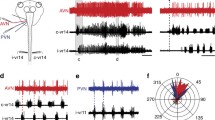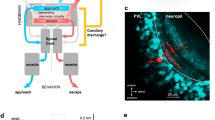Abstract
Corollary discharge signals associated with the motor command that elicits the electric organ discharge are prominent in the electrosensory lobe of mormyrid fish (Gnathonemus petersii). Central pathways and structures that convey these signals from the motor command nucleus to the electrosensory lobe are known anatomically, but these structures and their contributions to the various corollary discharge phenomena have not been examined physiologically. This study examines one such structure, the mesencephalic command associated nucleus (MCA).
Recordings from MCA cells show a highly stereotyped two spike response. The first spike of the response has a latency of about 2.5 ms following the initiation of the electric organ discharge (EOD) motor command which is about 5.5 ms before the occurrence of the EOD.
Results from stimulation and lesion experiments indicate that MCA is responsible for: 1) the gate-like corollary discharge-driven inhibition of the knollenorgan pathway; 2) the gate-like corollary discharge-driven excitation of granule cells in the mormyromast regions of the electrosensory lobe; and 3) various excitatory effects on other cells in the mormyromast regions.
Some corollary discharge phenomena are still present after MCA lesions, including the earliest corollary discharge effects and the plasticity that follows pairing with electrosensory stimuli. These phenomena must be mediated by structures other than MCA.
Similar content being viewed by others
Abbreviations
- BCA :
-
bulbar command associated nucleus
- C EOD :
-
motor command
- C3 :
-
central cerebellar lobule 3
- COM EOD:
-
motor command nucleus
- DLZ :
-
dorsolateral zone of ELL cortex
- EGa :
-
eminentia granularis anterior
- EGp :
-
eminentia granularis posterior
- ELa :
-
nucleus exterolateralis anterior
- ELL :
-
electrosensory lobe
- ELLml :
-
molecular layer of ELL cortex
- EOD :
-
electric organ discharge
- gang :
-
ganglion layer
- gran :
-
granule layer
- jlem :
-
juxtalemniscal region
- JLl :
-
lateral juxtalobar nucleus
- JLm :
-
medial juxtalobar nucleus
- lat :
-
nucleus lateralis
- ll :
-
lateral lemniscus
- MCA :
-
mesencephalic command associated nucleus
- mol :
-
molecular layer
- MOml :
-
molecular layer of the medial octavolateral nucleus
- MRN :
-
medullary relay nucleus
- MZ :
-
medial zone of ELL cortex
- nALL :
-
anterior lateral line nerve
- NELL :
-
nucleus of the electrosensory lobe
- nX :
-
cranial nerve X (vagus)
- OT :
-
optic tectum
- PCA :
-
paratrigeminal command associated nucleus
- pee :
-
praeeminentialis electrosensory tract
- plex :
-
plexiform layer
- prae :
-
nucleus praeeminentialis
- sublem :
-
sublemniscal nucleus
- TEL :
-
telencephalon
- VLZ :
-
ventrolateral zone of ELL cortex
- vped :
-
valvular peduncle
References
Aljure E (1964) Neuronal control system of electric organ discharges in Mormyridae. PhD Thesis, Columbia University, New York
Bell CC (1982) Properties of a modifiable efference copy in electric fish. J Neurophysiol 47: 1043–1056
Bell CC (1989) Sensory coding and corollary discharge effects in mormyrid electric fish. J Exp Biol 146: 229–253
Bell CC (1990) Mormyromast electroreceptor organs and their afferents in mormyrid electric fish. II. Intra-axonal recordings show initial stages of central processing. J Neurophysiol 63: 303–318
Bell CC, von der Emde G (1995) Electric organ corollary discharge pathways in mormyrid fish. II. The medial juxtalobar nucleus. J Comp Physiol A 177: 463–479
Bell CC, Grant K (1989) Corollary discharge inhibition and preservation of temporal information in a sensory nucleus of mormyrid electric fish. J Neurosci 9: 1029–1044
Bell CC, Grant K (1992) Corollary discharge effects and sensory processing in the mormyromast regions of the mormyrid electrosensory lobe. II. Cell types and corollary discharge plasticity. J Neurophysiol 68: 859–875
Bell CC, Szabo T (1986) Electroreception in mormyrid fish: central anatomy. In: Bullock TH, Heiligenberg W (eds) Electroreception. John Wiley & Sons, New York, pp 375–421
Bell CC, Finger TE, Russell CJ (1981) Central connections of the posterior lateral line lobe in mormyrid fish. Exp Brain Res 42: 9–22
Bell CC, Libouban S, Szabo T (1983) Pathways of the electric organ discharge command and its corollary discharges in mormyrid fish. J Comp Neurol 216: 327–338
Bell CC, Caputi A, Grant K, Serrier J (1993) Storage of a sensory pattern by anti-Hebbian synaptic plasticity in an electric fish. Proc Natl Acad Sci USA 90: 4650–4654
Bennett MVL, Pappas GD, Aljure E, Nakajima Y (1967) Physiology and ultrastructure of electrotonic junctions. II. Spinal and medullary electromotor nuclei in mormyrid fish. J Neurophysiol 30: 180–208
Clausse S (1986) Comparison du centre initiateur de la commande motrice de la décharge électrique chez deux espèces de poissons, par une étude morpho-functionelle. Thèse de Doctorat de l'Université de Paris 6
Grant K, Bell CC, Clausse S, Ravaille M (1986) Morphology and physiology of the brainstem nuclei controlling the electric organ discharge in mormyrid fish. J Comp Neurol 245: 514–530
Holst von E, Mittelstaedt H (1950) Das Reafferenzprinzip. Naturwissenschaften 37: 464–476
Hopkins CD (1986) Behavior of mormyridae. In: Bullock TH, Heiligenberg W (eds) Electroreception. John Wiley & Sons, New York, pp 527–571
Maler L (1973) The posterior lateral line lobe of a mormyrid fish—a Golgi study. J Comp Neurol 152: 281–299
Meek J (1992) Structural organization of the mormyrid electrosensory lateral line lobe. J Comp Physiol A 173: 675–677
Mugnaini E, Maler L (1987) Cytology and immunohistochemistry of the nucleus of the lateral line lobe in the electric fish Gnathonemus petersii (Mormyridae) brain. Evidence suggesting that GABAergic synapses mediate an inhibitory corollary discharge. Synapse 1: 32–56
Zipser B, Bennett MVL (1976) Interaction of electrosensory and electromotor signals in the lateral line lobe of a mormyrid fish. J Neurophysiol 39: 713–721
Author information
Authors and Affiliations
Rights and permissions
About this article
Cite this article
Bell, C., Dunn, K., Hall, C. et al. Electric organ corollary discharge pathways in mormyrid fish. J Comp Physiol A 177, 449–462 (1995). https://doi.org/10.1007/BF00187481
Accepted:
Issue Date:
DOI: https://doi.org/10.1007/BF00187481




